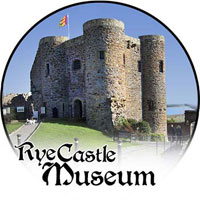Watch Bell Street
By Jean Floyd
A visitor from the 1840s visiting Rye today would recognise much of it: the Landgate, the street pattern within the walls, Ypres Tower, the stone buildings that survived the fire of 1377, many of the houses, the cobbles, but oh, how much else has changed! Take Watchbell Street as an example:
Population:
Today fewer than 50 people live on the stretch between the Hope Anchor and the Methodist Church (which of course was not there in our visitor’s day)–and not a single one of them is a child. In the 1840s there were nearly five times that number (285 persons in 1841), and a third of these were children!
In that year a detour down Hucksteps Row would have found some 80 further residents, over half of them children, in 17 houses. (Today would find fewer than 10 persons in 6 houses). There were multiple interrelationships among neighbours. A child might have 35 cousins living nearby.
Households contained up to 10 people, usually a mixture of generations and relatives. For example, in one household lived a widower with a grown unmarried daughter, a widowed son with his child, a niece, a couple of lodgers or ‘scholars’, an annuitant relative and a relative of ‘deranged mind’ (a census term)…. Some households had live-in servants.
Though Rye’s mortality rate was better than many towns, there were many widows of men who drowned at sea and many children being raised by grandparents, single parents or aunts because their mother had died in childbirth. With no provision for the unemployed there were many paupers, and there was no provision for the ‘mentally deranged’.
Rich and poor lived cheek by jowl in the 1500s and 1600s, then separated for tax reasons, but in the 1800s they were well mixed again: fishermen, agricultural labourers, journeymen (carpenters, blacksmiths, boot makers without their own work premises); shipbuilders, merchants, solicitors, gentry; people who became mayors, town clerks, head of the workhouse or borough officers. One solicitor/town clerk sent his son to Oxford.
Occupations:
Most men were in marine occupations: shipwrights, mariners, pilots, smack owners, fishermen, ships’ carpenters, etc. — or in related services (mainly provisions and clothing). They would be up and down the various steps then leading down the cliff to the shipyards because the Strand in the mid 19th century was busy and prosperous – and noisy with all the hammering, loading and unloading. Large numbers of well-regarded ships were built here and travelled all over the world carrying emigrants as well as goods. Regular packets sailed to Boulogne and London.
What of the women? Spinsters and widows were female servants, charwomen, laundresses, dressmakers, milliners, straw bonnet makers, shrimp sellers; there was a lady who ‘picks and gets ready all kinds of poultry, game, etc. in the shortest notice’. But there were also a growing number of schoolmistresses, governesses and ‘companions’. Although a wife belonged to the husband and had few if any rights to property, children or even their own inheritance, there were some notable exceptions on Watchbell Street: grocers, pub managers, property owners, gentry…. (They deserve an article of their own.)
Few children went to school in 1840; parents couldn’t afford the penny a week fee, or shoes for their children who in any case were needed to work. However, schooling was slowly becoming ‘normal’ even before it became compulsory in 1880, and during Victorian and Edwardian times there were at least ten schools of various types and sizes on Watchbell Street.
During the Victorian years (1837-1901), Watchbell Street provided ten of the town mayors. serving up to 11 years each–and that doesn’t count five times mayor Jeremiah Smith who owned houses on Watchbell Street but did not himself live here. The street also provided all three Town Clerks of the period, as well as Clerks of the Peace, Justices of the Peace, the Headmaster of Thomas Peacock, heads of shipbuilding firms, the Harbourmaster and the Clerk of the Rye Union (workhouse).
Living Conditions:
Water had to be fetched from a pump until 1880, and there were outdoor privies, usually at the bottom of the garden, until the 1920s and later. You would probably rather not imagine how the street smelled what with no indoor sanitation and fish drying everywhere. Candles were used for lighting into the 1930s, though there were some gas street lights from 1846.
For most people, the only means of transport was their own feet, though boats did ply the river. The town was transformed by the railway which arrived in 1841. With the railway came new blood. No longer had everyone who lived here been born within a radius of a few miles with everyone related to everyone else.
